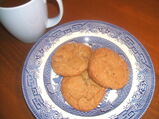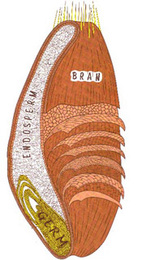Quick breads are breads that do not require kneading and a rising time. They are leavened with baking powder or baking soda and sometimes a combination of the two. This includes, muffins, biscuits, scones and a large variety of sweet and savory loaf breads.
There are two methods; the stirred method which is the simplest and the creamed which are usually richer and more cake like. No matter which method your recipe uses you want your finished product to be tender and moist. Since it's whole grain it's slower to absorb the liquid ingredients and will benefit from a short 10 minute rest to allow the flour to fully hydrate before baking.
Stirred: In one bowl add all the dry ingredients combine well. In another bowl is all the beaten liquid ingredients. To mix, add the liquid ingredients to the dry ones and with a few swift strokes beat them together. The mixing is held to an absolute minimum, which will leave some lumps, ignore them. The batter should not be mixed to the point of pouring. If the batter is mixed to long, the gluten in the flour will develop and toughen the final product.
The crumb of the finished product should be even, and moist. If it's coarse and full of tunnels you over- mixed the batter.
Creamed: If the recipe calls for creaming the soft butter, sugar and then beating in the eggs this is the creamed method, which usually creates a more cake like product. The amount of mixing is not as critical. After creaming the wet ingredients, the dry ingredients are added to the mixture and everything beaten again to form a batter. This batter will be more like cake batter, smooth and pourable.
There are two methods; the stirred method which is the simplest and the creamed which are usually richer and more cake like. No matter which method your recipe uses you want your finished product to be tender and moist. Since it's whole grain it's slower to absorb the liquid ingredients and will benefit from a short 10 minute rest to allow the flour to fully hydrate before baking.
Stirred: In one bowl add all the dry ingredients combine well. In another bowl is all the beaten liquid ingredients. To mix, add the liquid ingredients to the dry ones and with a few swift strokes beat them together. The mixing is held to an absolute minimum, which will leave some lumps, ignore them. The batter should not be mixed to the point of pouring. If the batter is mixed to long, the gluten in the flour will develop and toughen the final product.
The crumb of the finished product should be even, and moist. If it's coarse and full of tunnels you over- mixed the batter.
Creamed: If the recipe calls for creaming the soft butter, sugar and then beating in the eggs this is the creamed method, which usually creates a more cake like product. The amount of mixing is not as critical. After creaming the wet ingredients, the dry ingredients are added to the mixture and everything beaten again to form a batter. This batter will be more like cake batter, smooth and pourable.


 RSS Feed
RSS Feed
